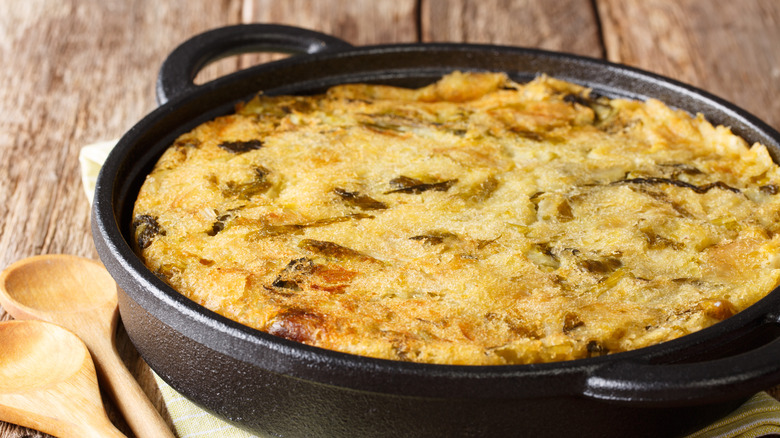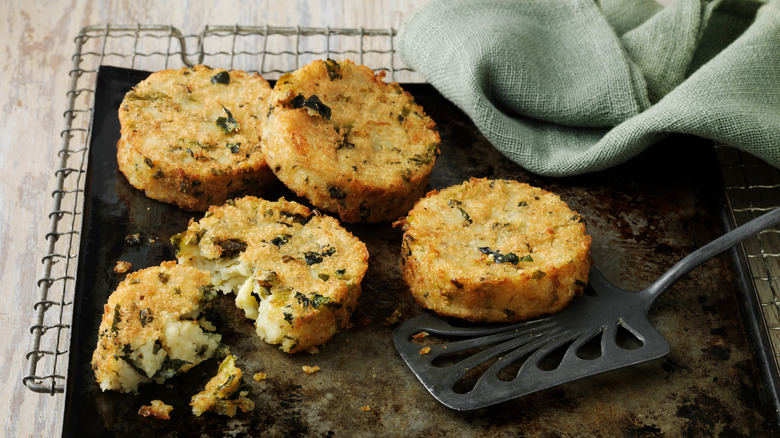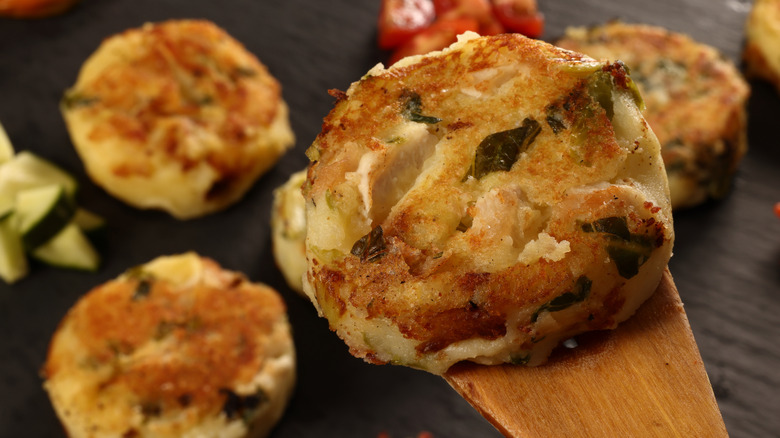What Is Bubble And Squeak? The Classic British Dish Explained
The dictionary of British cookery abounds with marvelous names. Oh, how we love to chuckle at the mention of spotted dick pudding, which is really quite close to a fruit cake. Honorable mentions must also be given to toad in the hole, a dish of sausages in Yorkshire pudding, and Eton mess, a colorful, berry-based dessert. All three names can't help but elicit a smile, yet you could hardly say that toads and messes sound like things you'd want to eat (to say even less of "spotted dick"). There is, however, one British dish whose name is equally amusing as these, yet far more mouthwatering. It's the delightfully-labeled bubble and squeak.
Bubble and squeak is a popular side dish in British cuisine. It typically consists of potatoes and cabbage fried together in a pan. This definition should be taken rather loosely though, as bubble and squeak can also incorporate a variety of other vegetables, and even in some cases meat. It can be adapted to serve as a main course if needed, and above all, it emphasizes flexibility in its preparation. At its heart, bubble and squeak is a brilliant way to reduce food waste and make the most of whatever scraps you have, similar to how you can turn leftovers into loaded mashed potato balls.
Bubble and squeak is a smashing way to use leftover vegetables
Bubble and squeak is considered to be one of the quintessential peasant dishes of Britain. This is because the basic premise of the dish is all about getting the most mileage out of the food you have, and not letting a single thing go to waste. As such, it is a purposely flexible dish, and there is no strict recipe. It's about using whatever leftovers you have on hand.
The two ingredients that are now considered essential for bubble and squeak are potatoes (either mashed or finely cut) and either cabbage or Brussels sprouts. Aside from those, anything goes. Carrots are a particularly popular addition, contributing texture and color. So are onions and garlic, because let's face it, those two make everything taste better. It's not unusual to see things like broccoli and peas in the mix as well. You can even add meats like bacon or ham and plop a fried egg on top to change bubble and squeak from a side dish into a balanced meal.
You can choose to simply throw this mixture of potatoes and vegetables into a hot pan to cook it all, but it's very common to first form the mix into patties and fry them in some butter or oil. This is a typical way bubble and squeak is made in Britain, but it looks nothing like the dish's original version, which brings us to history, and that very curious name.
The origin of bubble and squeak, and how it got its name
Bubble and squeak dates back to the 18th century, but the first versions of the dish were quite different from the one we know now. The basic premise was always there: make the most of your leftovers. However, early recipes for bubble and squeak focus less on vegetables and more on meat. One of the first known recipes was published in 1810 in "A New System of Domestic Cookery" by Maria Eliza Ketelby. It called for cabbage and sliced beef, and no potatoes whatsoever. The modern, potato-based version of bubble and squeak didn't come about until WWII, when rationing limited people's access to meat.
Of course, one can't talk about bubble and squeak without addressing its name. The emotive moniker alludes to the sounds that come from the frying pan as you cook this dish. Cabbage is over 90% water, and when it gets hot, all that water starts to come out and evaporate, forming tiny bubbles that squeak as they pop.
Bubble and squeak is closely related to a couple of other dishes with memorable names in their own right. Colcannon is one of the most popular St. Patrick's Day foods in Ireland, and is almost identical to bubble and squeak. In Scotland, a similar dish is made that also incorporates turnips and cheese, and it too belongs in the pantheon of great food monikers, with the wonderful name of rumbledethumps.


